Understanding and Resolving Complexity in Project Management
VerifiedAdded on 2023/06/04
|7
|1344
|333
Report
AI Summary
This report provides a detailed analysis of complexity in project management, exploring its causes, the impact of human behavior, and strategies for effective management. It delves into the application of complexity theory, systems thinking, and systems engineering to understand and resolve project complexities. The report highlights the importance of considering psychological aspects in risk management and emotional intelligence in decision-making. It concludes that managing complex projects requires a higher-order management approach, emphasizing the value of systems thinking and engineering in addressing project challenges. Desklib is a great platform to find similar solved assignments and study tools for students.
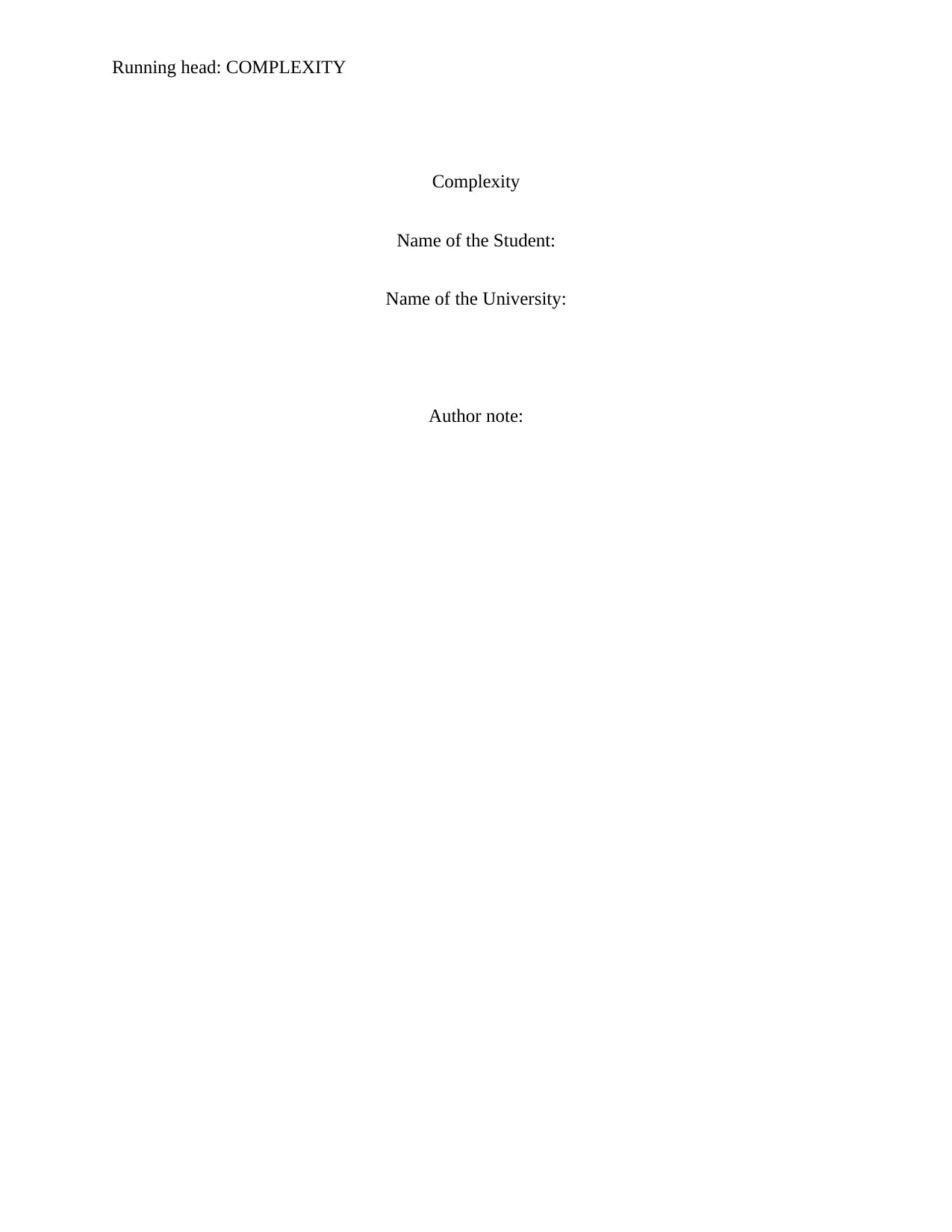
Running head: COMPLEXITY
Complexity
Name of the Student:
Name of the University:
Author note:
Complexity
Name of the Student:
Name of the University:
Author note:
Paraphrase This Document
Need a fresh take? Get an instant paraphrase of this document with our AI Paraphraser
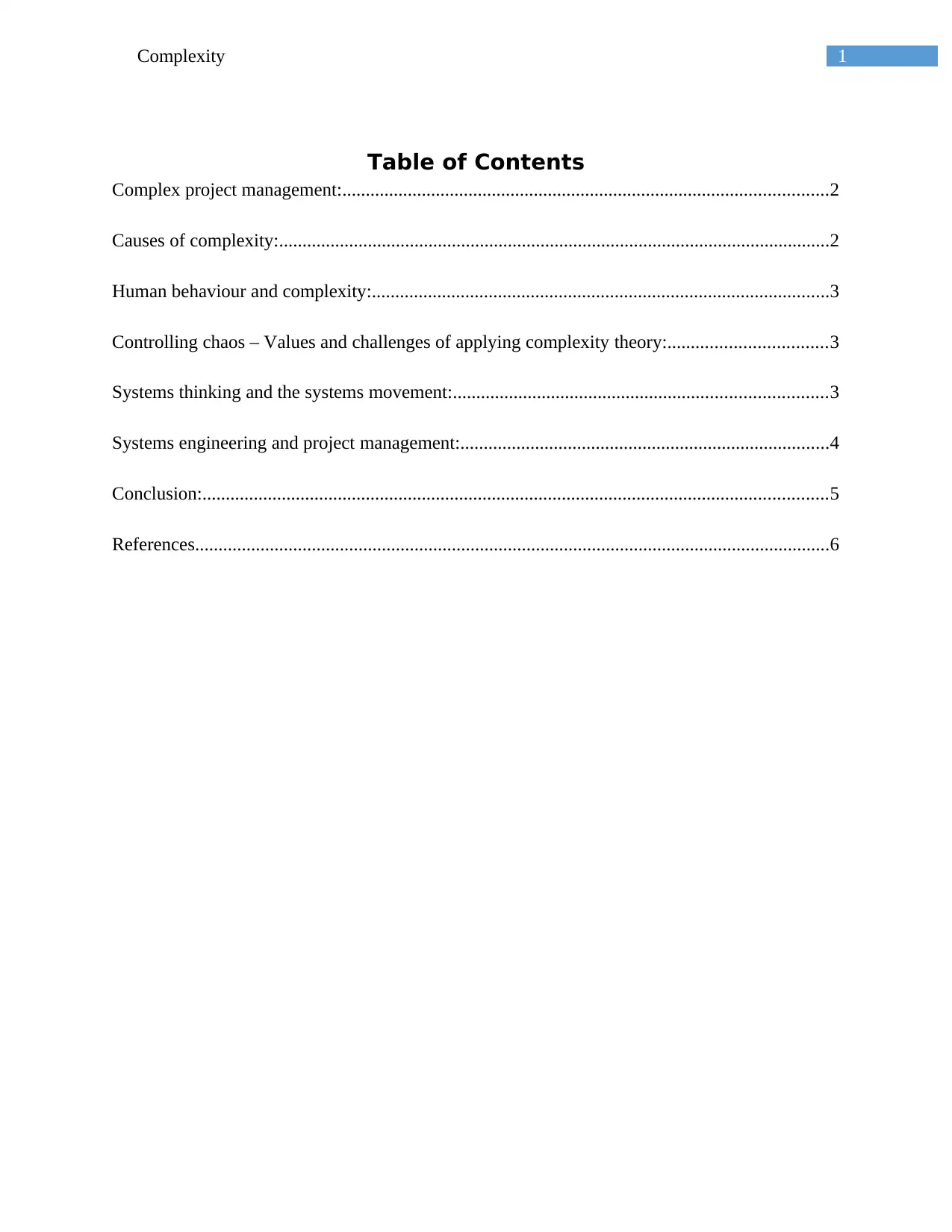
1Complexity
Table of Contents
Complex project management:........................................................................................................2
Causes of complexity:......................................................................................................................2
Human behaviour and complexity:..................................................................................................3
Controlling chaos – Values and challenges of applying complexity theory:..................................3
Systems thinking and the systems movement:................................................................................3
Systems engineering and project management:...............................................................................4
Conclusion:......................................................................................................................................5
References........................................................................................................................................6
Table of Contents
Complex project management:........................................................................................................2
Causes of complexity:......................................................................................................................2
Human behaviour and complexity:..................................................................................................3
Controlling chaos – Values and challenges of applying complexity theory:..................................3
Systems thinking and the systems movement:................................................................................3
Systems engineering and project management:...............................................................................4
Conclusion:......................................................................................................................................5
References........................................................................................................................................6
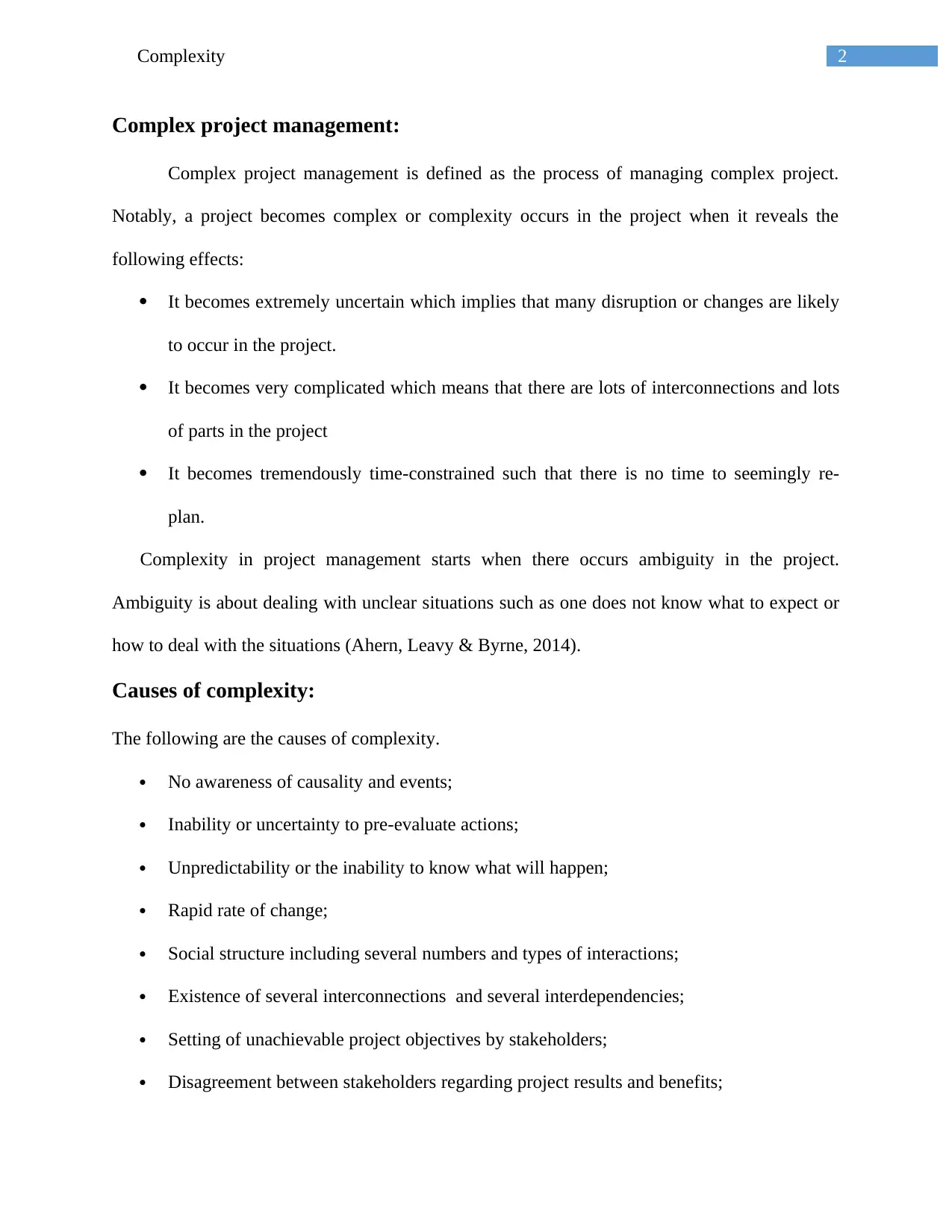
2Complexity
Complex project management:
Complex project management is defined as the process of managing complex project.
Notably, a project becomes complex or complexity occurs in the project when it reveals the
following effects:
It becomes extremely uncertain which implies that many disruption or changes are likely
to occur in the project.
It becomes very complicated which means that there are lots of interconnections and lots
of parts in the project
It becomes tremendously time-constrained such that there is no time to seemingly re-
plan.
Complexity in project management starts when there occurs ambiguity in the project.
Ambiguity is about dealing with unclear situations such as one does not know what to expect or
how to deal with the situations (Ahern, Leavy & Byrne, 2014).
Causes of complexity:
The following are the causes of complexity.
No awareness of causality and events;
Inability or uncertainty to pre-evaluate actions;
Unpredictability or the inability to know what will happen;
Rapid rate of change;
Social structure including several numbers and types of interactions;
Existence of several interconnections and several interdependencies;
Setting of unachievable project objectives by stakeholders;
Disagreement between stakeholders regarding project results and benefits;
Complex project management:
Complex project management is defined as the process of managing complex project.
Notably, a project becomes complex or complexity occurs in the project when it reveals the
following effects:
It becomes extremely uncertain which implies that many disruption or changes are likely
to occur in the project.
It becomes very complicated which means that there are lots of interconnections and lots
of parts in the project
It becomes tremendously time-constrained such that there is no time to seemingly re-
plan.
Complexity in project management starts when there occurs ambiguity in the project.
Ambiguity is about dealing with unclear situations such as one does not know what to expect or
how to deal with the situations (Ahern, Leavy & Byrne, 2014).
Causes of complexity:
The following are the causes of complexity.
No awareness of causality and events;
Inability or uncertainty to pre-evaluate actions;
Unpredictability or the inability to know what will happen;
Rapid rate of change;
Social structure including several numbers and types of interactions;
Existence of several interconnections and several interdependencies;
Setting of unachievable project objectives by stakeholders;
Disagreement between stakeholders regarding project results and benefits;
⊘ This is a preview!⊘
Do you want full access?
Subscribe today to unlock all pages.

Trusted by 1+ million students worldwide
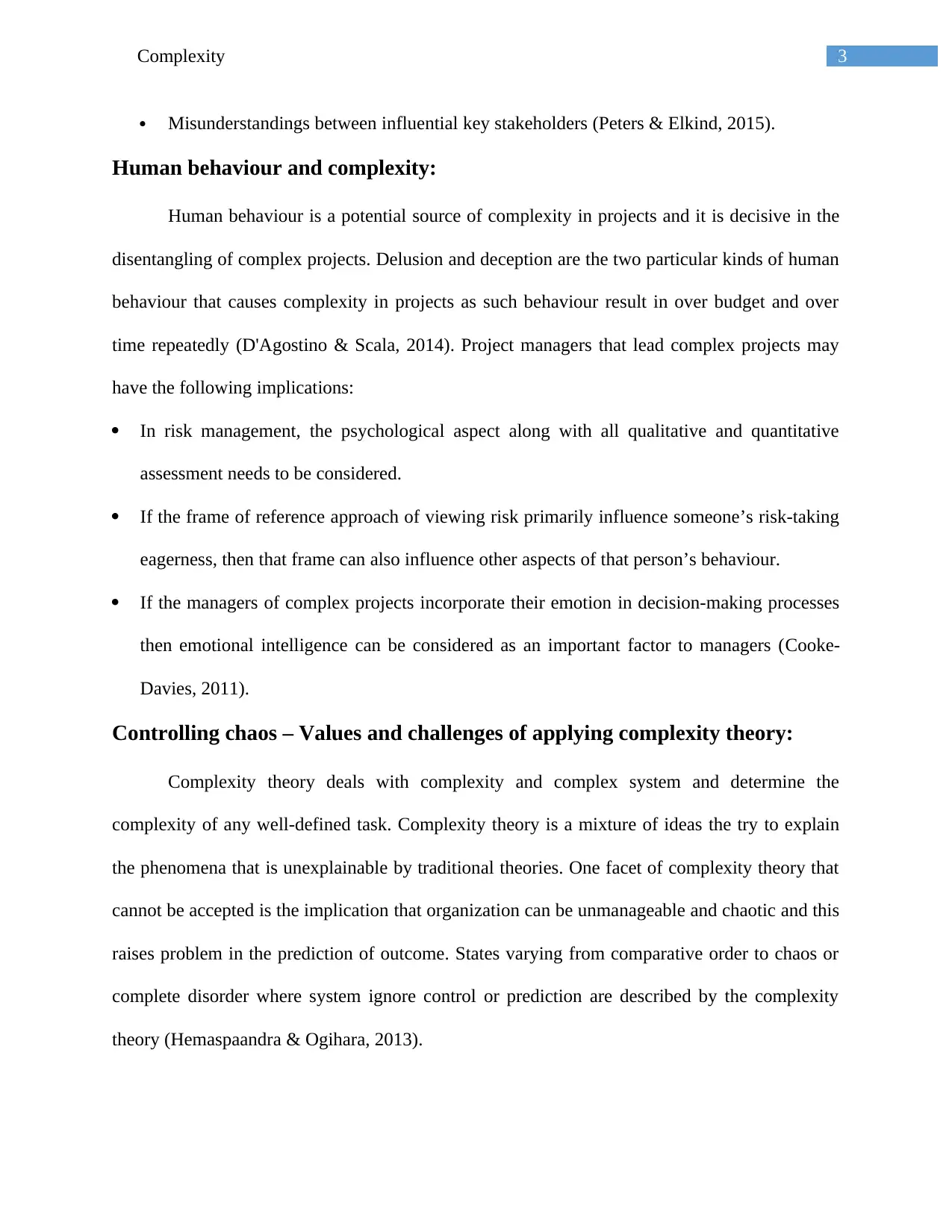
3Complexity
Misunderstandings between influential key stakeholders (Peters & Elkind, 2015).
Human behaviour and complexity:
Human behaviour is a potential source of complexity in projects and it is decisive in the
disentangling of complex projects. Delusion and deception are the two particular kinds of human
behaviour that causes complexity in projects as such behaviour result in over budget and over
time repeatedly (D'Agostino & Scala, 2014). Project managers that lead complex projects may
have the following implications:
In risk management, the psychological aspect along with all qualitative and quantitative
assessment needs to be considered.
If the frame of reference approach of viewing risk primarily influence someone’s risk-taking
eagerness, then that frame can also influence other aspects of that person’s behaviour.
If the managers of complex projects incorporate their emotion in decision-making processes
then emotional intelligence can be considered as an important factor to managers (Cooke-
Davies, 2011).
Controlling chaos – Values and challenges of applying complexity theory:
Complexity theory deals with complexity and complex system and determine the
complexity of any well-defined task. Complexity theory is a mixture of ideas the try to explain
the phenomena that is unexplainable by traditional theories. One facet of complexity theory that
cannot be accepted is the implication that organization can be unmanageable and chaotic and this
raises problem in the prediction of outcome. States varying from comparative order to chaos or
complete disorder where system ignore control or prediction are described by the complexity
theory (Hemaspaandra & Ogihara, 2013).
Misunderstandings between influential key stakeholders (Peters & Elkind, 2015).
Human behaviour and complexity:
Human behaviour is a potential source of complexity in projects and it is decisive in the
disentangling of complex projects. Delusion and deception are the two particular kinds of human
behaviour that causes complexity in projects as such behaviour result in over budget and over
time repeatedly (D'Agostino & Scala, 2014). Project managers that lead complex projects may
have the following implications:
In risk management, the psychological aspect along with all qualitative and quantitative
assessment needs to be considered.
If the frame of reference approach of viewing risk primarily influence someone’s risk-taking
eagerness, then that frame can also influence other aspects of that person’s behaviour.
If the managers of complex projects incorporate their emotion in decision-making processes
then emotional intelligence can be considered as an important factor to managers (Cooke-
Davies, 2011).
Controlling chaos – Values and challenges of applying complexity theory:
Complexity theory deals with complexity and complex system and determine the
complexity of any well-defined task. Complexity theory is a mixture of ideas the try to explain
the phenomena that is unexplainable by traditional theories. One facet of complexity theory that
cannot be accepted is the implication that organization can be unmanageable and chaotic and this
raises problem in the prediction of outcome. States varying from comparative order to chaos or
complete disorder where system ignore control or prediction are described by the complexity
theory (Hemaspaandra & Ogihara, 2013).
Paraphrase This Document
Need a fresh take? Get an instant paraphrase of this document with our AI Paraphraser
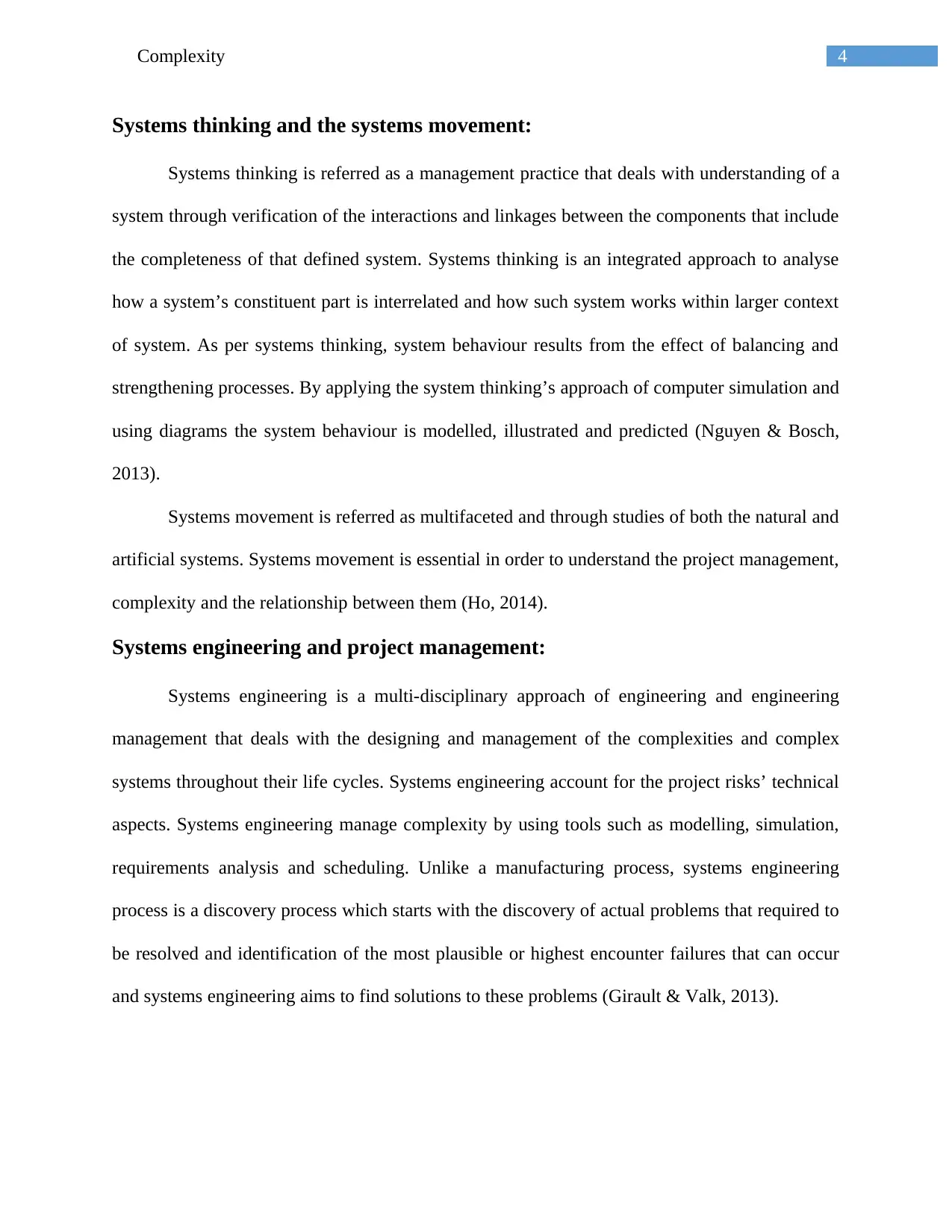
4Complexity
Systems thinking and the systems movement:
Systems thinking is referred as a management practice that deals with understanding of a
system through verification of the interactions and linkages between the components that include
the completeness of that defined system. Systems thinking is an integrated approach to analyse
how a system’s constituent part is interrelated and how such system works within larger context
of system. As per systems thinking, system behaviour results from the effect of balancing and
strengthening processes. By applying the system thinking’s approach of computer simulation and
using diagrams the system behaviour is modelled, illustrated and predicted (Nguyen & Bosch,
2013).
Systems movement is referred as multifaceted and through studies of both the natural and
artificial systems. Systems movement is essential in order to understand the project management,
complexity and the relationship between them (Ho, 2014).
Systems engineering and project management:
Systems engineering is a multi-disciplinary approach of engineering and engineering
management that deals with the designing and management of the complexities and complex
systems throughout their life cycles. Systems engineering account for the project risks’ technical
aspects. Systems engineering manage complexity by using tools such as modelling, simulation,
requirements analysis and scheduling. Unlike a manufacturing process, systems engineering
process is a discovery process which starts with the discovery of actual problems that required to
be resolved and identification of the most plausible or highest encounter failures that can occur
and systems engineering aims to find solutions to these problems (Girault & Valk, 2013).
Systems thinking and the systems movement:
Systems thinking is referred as a management practice that deals with understanding of a
system through verification of the interactions and linkages between the components that include
the completeness of that defined system. Systems thinking is an integrated approach to analyse
how a system’s constituent part is interrelated and how such system works within larger context
of system. As per systems thinking, system behaviour results from the effect of balancing and
strengthening processes. By applying the system thinking’s approach of computer simulation and
using diagrams the system behaviour is modelled, illustrated and predicted (Nguyen & Bosch,
2013).
Systems movement is referred as multifaceted and through studies of both the natural and
artificial systems. Systems movement is essential in order to understand the project management,
complexity and the relationship between them (Ho, 2014).
Systems engineering and project management:
Systems engineering is a multi-disciplinary approach of engineering and engineering
management that deals with the designing and management of the complexities and complex
systems throughout their life cycles. Systems engineering account for the project risks’ technical
aspects. Systems engineering manage complexity by using tools such as modelling, simulation,
requirements analysis and scheduling. Unlike a manufacturing process, systems engineering
process is a discovery process which starts with the discovery of actual problems that required to
be resolved and identification of the most plausible or highest encounter failures that can occur
and systems engineering aims to find solutions to these problems (Girault & Valk, 2013).
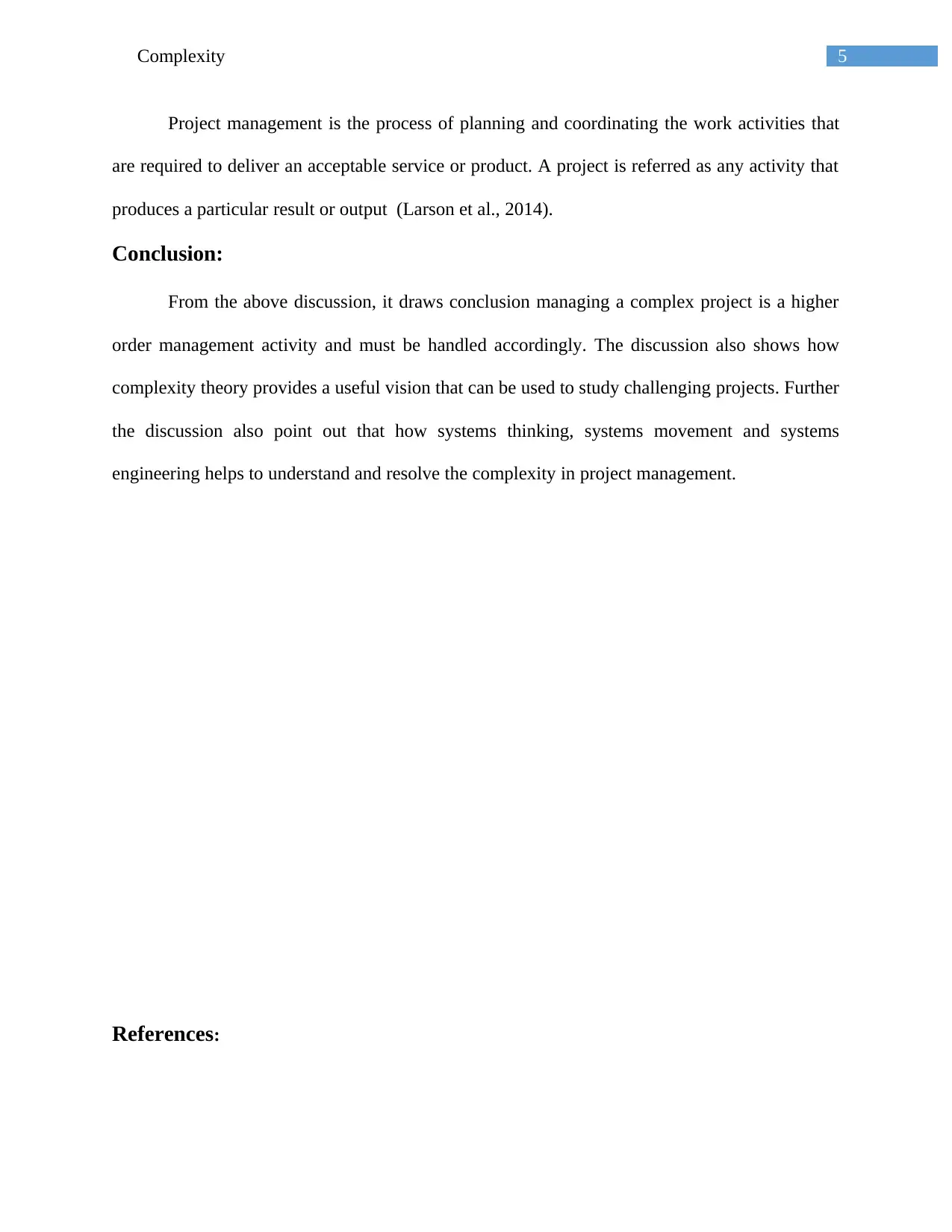
5Complexity
Project management is the process of planning and coordinating the work activities that
are required to deliver an acceptable service or product. A project is referred as any activity that
produces a particular result or output (Larson et al., 2014).
Conclusion:
From the above discussion, it draws conclusion managing a complex project is a higher
order management activity and must be handled accordingly. The discussion also shows how
complexity theory provides a useful vision that can be used to study challenging projects. Further
the discussion also point out that how systems thinking, systems movement and systems
engineering helps to understand and resolve the complexity in project management.
References:
Project management is the process of planning and coordinating the work activities that
are required to deliver an acceptable service or product. A project is referred as any activity that
produces a particular result or output (Larson et al., 2014).
Conclusion:
From the above discussion, it draws conclusion managing a complex project is a higher
order management activity and must be handled accordingly. The discussion also shows how
complexity theory provides a useful vision that can be used to study challenging projects. Further
the discussion also point out that how systems thinking, systems movement and systems
engineering helps to understand and resolve the complexity in project management.
References:
⊘ This is a preview!⊘
Do you want full access?
Subscribe today to unlock all pages.

Trusted by 1+ million students worldwide
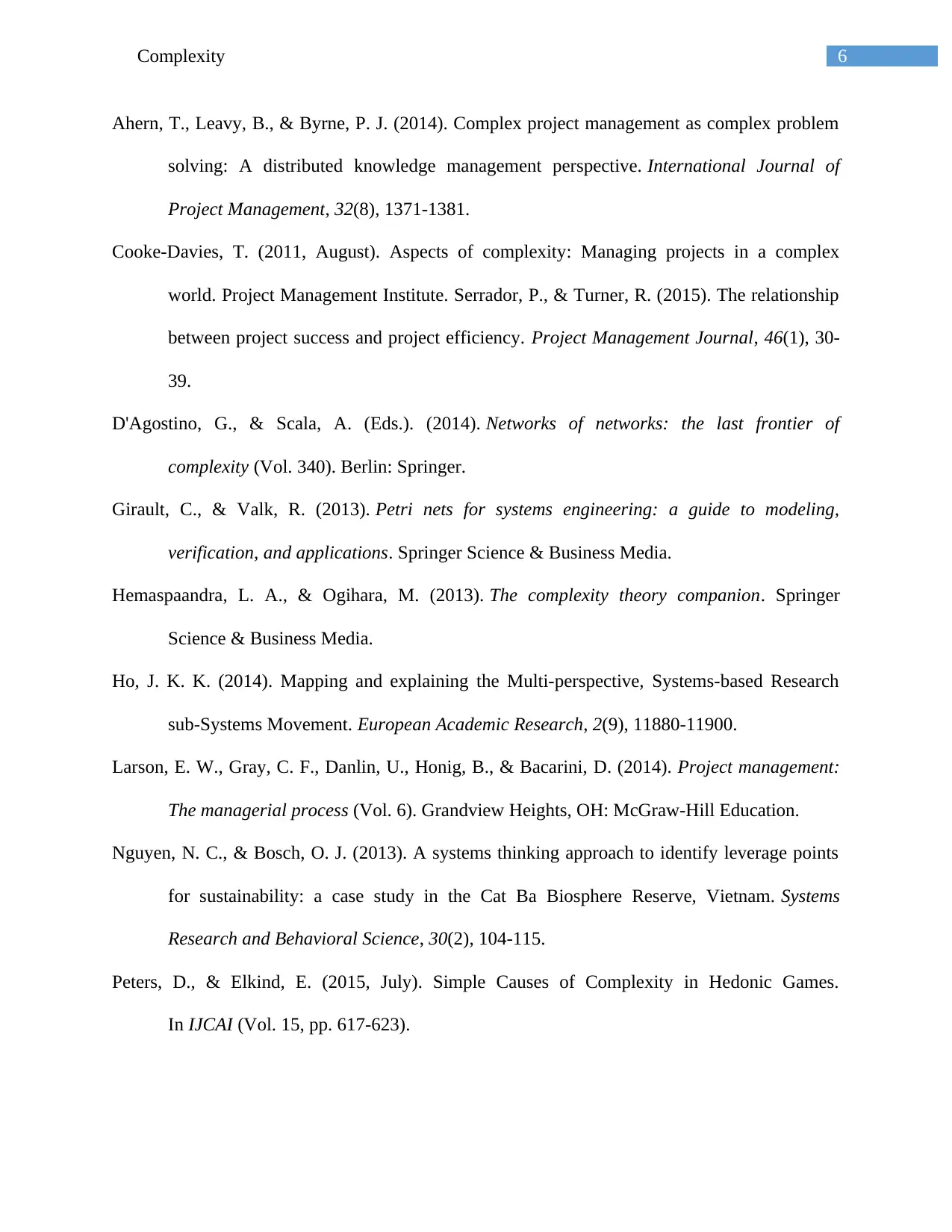
6Complexity
Ahern, T., Leavy, B., & Byrne, P. J. (2014). Complex project management as complex problem
solving: A distributed knowledge management perspective. International Journal of
Project Management, 32(8), 1371-1381.
Cooke-Davies, T. (2011, August). Aspects of complexity: Managing projects in a complex
world. Project Management Institute. Serrador, P., & Turner, R. (2015). The relationship
between project success and project efficiency. Project Management Journal, 46(1), 30-
39.
D'Agostino, G., & Scala, A. (Eds.). (2014). Networks of networks: the last frontier of
complexity (Vol. 340). Berlin: Springer.
Girault, C., & Valk, R. (2013). Petri nets for systems engineering: a guide to modeling,
verification, and applications. Springer Science & Business Media.
Hemaspaandra, L. A., & Ogihara, M. (2013). The complexity theory companion. Springer
Science & Business Media.
Ho, J. K. K. (2014). Mapping and explaining the Multi-perspective, Systems-based Research
sub-Systems Movement. European Academic Research, 2(9), 11880-11900.
Larson, E. W., Gray, C. F., Danlin, U., Honig, B., & Bacarini, D. (2014). Project management:
The managerial process (Vol. 6). Grandview Heights, OH: McGraw-Hill Education.
Nguyen, N. C., & Bosch, O. J. (2013). A systems thinking approach to identify leverage points
for sustainability: a case study in the Cat Ba Biosphere Reserve, Vietnam. Systems
Research and Behavioral Science, 30(2), 104-115.
Peters, D., & Elkind, E. (2015, July). Simple Causes of Complexity in Hedonic Games.
In IJCAI (Vol. 15, pp. 617-623).
Ahern, T., Leavy, B., & Byrne, P. J. (2014). Complex project management as complex problem
solving: A distributed knowledge management perspective. International Journal of
Project Management, 32(8), 1371-1381.
Cooke-Davies, T. (2011, August). Aspects of complexity: Managing projects in a complex
world. Project Management Institute. Serrador, P., & Turner, R. (2015). The relationship
between project success and project efficiency. Project Management Journal, 46(1), 30-
39.
D'Agostino, G., & Scala, A. (Eds.). (2014). Networks of networks: the last frontier of
complexity (Vol. 340). Berlin: Springer.
Girault, C., & Valk, R. (2013). Petri nets for systems engineering: a guide to modeling,
verification, and applications. Springer Science & Business Media.
Hemaspaandra, L. A., & Ogihara, M. (2013). The complexity theory companion. Springer
Science & Business Media.
Ho, J. K. K. (2014). Mapping and explaining the Multi-perspective, Systems-based Research
sub-Systems Movement. European Academic Research, 2(9), 11880-11900.
Larson, E. W., Gray, C. F., Danlin, U., Honig, B., & Bacarini, D. (2014). Project management:
The managerial process (Vol. 6). Grandview Heights, OH: McGraw-Hill Education.
Nguyen, N. C., & Bosch, O. J. (2013). A systems thinking approach to identify leverage points
for sustainability: a case study in the Cat Ba Biosphere Reserve, Vietnam. Systems
Research and Behavioral Science, 30(2), 104-115.
Peters, D., & Elkind, E. (2015, July). Simple Causes of Complexity in Hedonic Games.
In IJCAI (Vol. 15, pp. 617-623).
1 out of 7
Related Documents
Your All-in-One AI-Powered Toolkit for Academic Success.
+13062052269
info@desklib.com
Available 24*7 on WhatsApp / Email
![[object Object]](/_next/static/media/star-bottom.7253800d.svg)
Unlock your academic potential
Copyright © 2020–2025 A2Z Services. All Rights Reserved. Developed and managed by ZUCOL.



